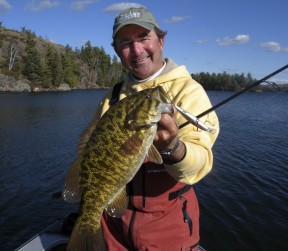 Judging from recent emails, it looks like lure color is the topic of the day. Indeed, George A. wrote that he likes “to fish with jigs and soft plastic grubs, but there are so many colors. Does colour really make a big difference to the fish, or is it just a marketing technique to sell more product? What are the most productive colors? I’ve been using white and smoke.”
Judging from recent emails, it looks like lure color is the topic of the day. Indeed, George A. wrote that he likes “to fish with jigs and soft plastic grubs, but there are so many colors. Does colour really make a big difference to the fish, or is it just a marketing technique to sell more product? What are the most productive colors? I’ve been using white and smoke.”
Along the same lines, Brandon asked about the best color lures to use “in clear, brown ,and bluish green pond waters. and does color matter on the weather? I have been wondering this for a while.”
Well, color is always a thorny topic, so let me step into this one gently by saying that while many recreational anglers think that the color of their lure is the most significant factor to catching fish, most professional anglers believe it’s way down the list of priorities. 
Indeed, when you are choosing a lure to tie on – without question, the key consideration always is depth control. Think of it this way: you may have selected the perfect color, but if you’re casting a topwater lure and the fish are relating the bottom, you’re not going to catch anything. So, you need to know how deep your lure is running at all times relative to the position of the fish. In fact, depth control is so important that all the other factors are secondary.
After depth control, however, speed control, the size and shape of your lure and its action (sound and vibration) are all important.
Only after you’ve considered all of these factors should you even begin to worry about color.
Then, however, it can be critically important.
I can’t tell George what colors are best because I don’t know what species he fishes for, the forage that is in his lakes and rivers, or the water clarity conditions. So let me pass along some color generalities.
Ask yourself, when would you pick a bait that is highly visible to the fish? Say, one that’s dyed an outrageous shade of orange? Or, when would you choose a lure that is natural looking? One that looks like the forage in a lake or river?
Well, if we use smallmouth bass as an example, early in the season, chartreuse is often an unbeatable smallmouth color. Smallmouth react to a yellow-skirted spinnerbait or a bright, chartreuse-tinted crankbait the way a bull reacts to a red flag.
It is because these spicy, yellowy-green hued baits mimic perch, which are a smallmouth’s dreaded foe. Throughout the spawning season, perch harass smallmouth bass by darting into their nests and eating their eggs.
 Even after the fry have hatched, packs of hungry perch still gobble up the young fingerlings. So, adult bass fresh from protecting their nests will often clobber yellowy-green colored baits. Of course, perch usually have to be found in the lake for this pattern to produce.
Even after the fry have hatched, packs of hungry perch still gobble up the young fingerlings. So, adult bass fresh from protecting their nests will often clobber yellowy-green colored baits. Of course, perch usually have to be found in the lake for this pattern to produce.
On the other hand, as the season progresses, more subtle colored lures, like brown, camo and smoke can be just the ticket. These colors mimic a crayfish, which is often the principal food of smallmouth bass. By the same token, if the smallmouth are conditioned to eating shad, smelt, tulibees or some other silvery forage, then a white, albino or black back/silver sided lure may be most productive.
For more of this article visit Outdoor Canada
Visit Gord Pyzer on Twitter @gordpyzer